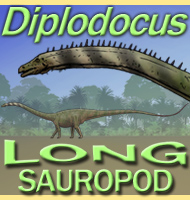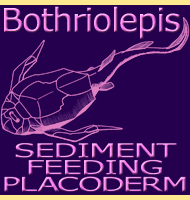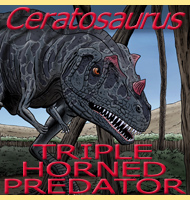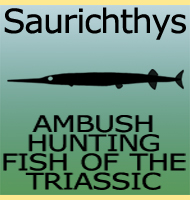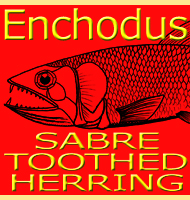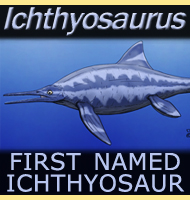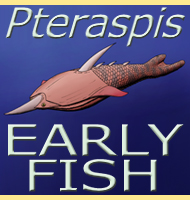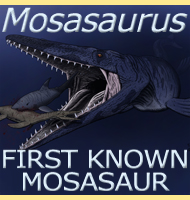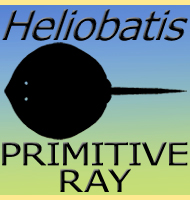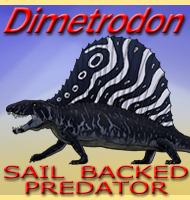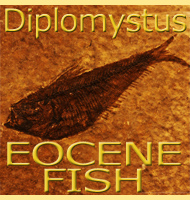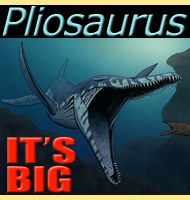


Top 10 Prehistoric fish
Before we begin we would just like to point out that while they are fish, sharks have been deliberately left out of this list because they already have their own top ten here. Don't forget, if you want more detailed information upon any of these fish, just click on the names.10 - Knightia
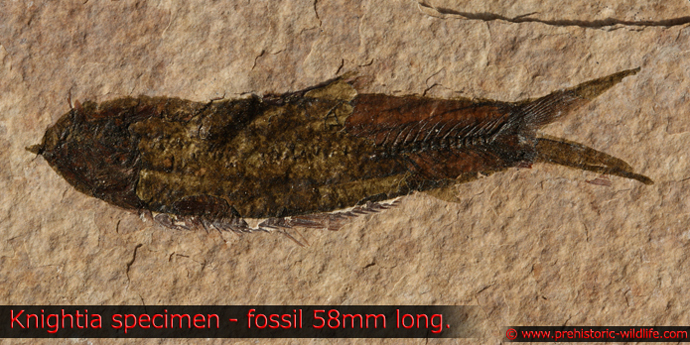
We’ll start off this list with a little fish from the Eocene that is represented by literally thousands of specimens, and is why it is one of the most common fossils offered to collectors. Knightia is a good example of how seemingly small and unimportant fish can make up a very important part of an ecosystem and provide much of the biomass that other animals feed upon.
9 - Eusthenopteron

Eusthenopteron was a lobe finned fish and one that for a long time was held up as an example of what the ancestors to land walking amphibians may have looked like. This is because the stout and powerful fins were seen as possibly being capable pushing the body out of the water and along the ground. More modern analysis however suggests that Eusthenopteron probably stayed within the water and used its strong fins to navigate submerged obstacles and shallows. In this respect Eusthenopteron is now considered to be an example of a group of fish that would eventually spawn the ancestral line that would lead towards the first amphibians that would then begin the vertebrate colonisation of the land.
8 - Xiphactinus
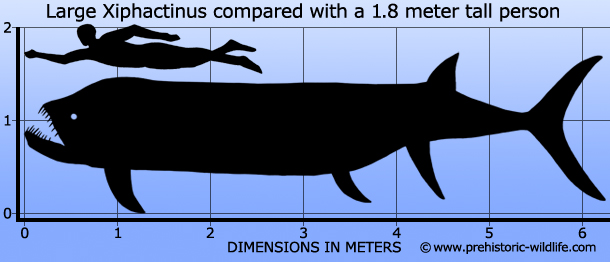
To survive in the seas of the late Cretaceous you needed to either be big or mean, but Xiphactinus was both. Xiphactinus could grow to such a size that it would trouble most modern day sharks (though perhaps not those of the Cretaceous), and it had very long needle like teeth that were perfect for piercing the scales and flesh of other fish. However, it was not able to chew or slice off smaller pieces and probably ate fish whole. There is even proof of this in a complete fossil specimen of Xiphactinus that has a complete Gillicus preserved inside of it.
7- Coccosteus
This is a surprisingly little known genus of arthrodire placoderm, but one that is very important to those interested in reconstructing these ancient fish. Because of their smaller overall size, and examples of exceptionally well preserved specimens, the softer body parts and not just the head plates can be reconstructed for far more accurate depictions of what the arthrodire placoderms looked like.
6 - Haikouichthys
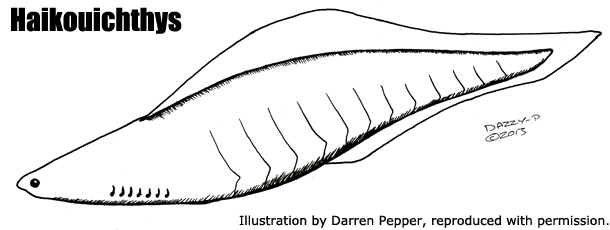
Easily the most primitive fish on this list, the discovery of Haikouichthys pushed back the known first appearance of fish by a full fifty million years before the previous known ancestor. There are still some details that we don’t know for certain about this genus, but it does illustrate how vertebrates had their origins in the oceans, as well as how long they existed before they made their first steps onto land.
5 - Leedsichthys
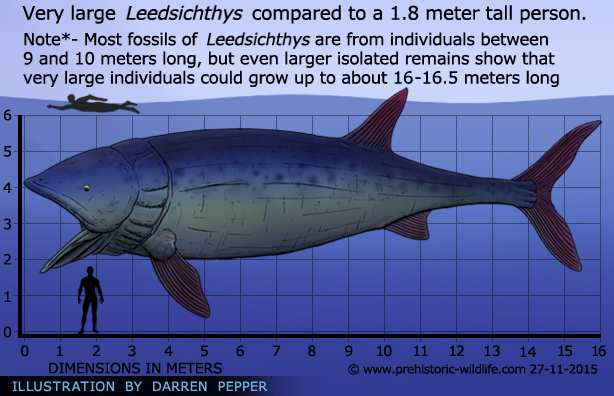
Leedsichthys was a giant of the Jurassic oceans, and for seemingly good reason since fish eating plesiosaurs had become very common by the time that this genus appeared. How this fish faired against the pliosaurs however is a little more uncertain. Like with many exceptionally large fish, Leedsichthys is believed to have been a filter feeder, which means that it probably swam near to the surface with is mouth open. As water passed in and through the gill slits, plankton and small invertebrates could be filtered out and consumed. This is both how and why Leedsichthys got so big, as having a big mouth meant that it could filter more food, and only having to swim forwards while feeding meant that energy expenditure was kept to a minimum, meaning more of the foods energy could go towards growth.
4 - Leptolepis
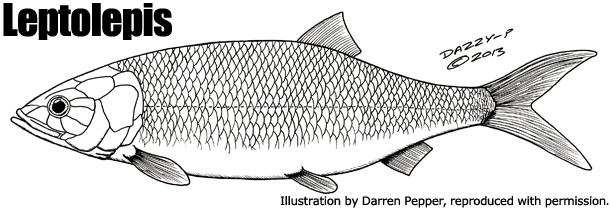
First appearing in the Jurassic and living into the Cretaceous, at the time of its description Leptolepis was the earliest bony fish known. This means that instead of having a cartilaginous skeleton, Leptolepis actually had bones
3 - Megapiranha
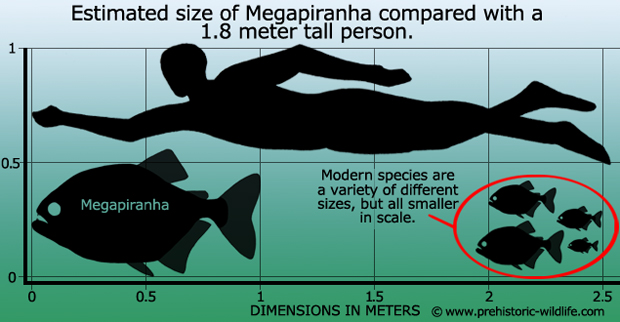
Absolutely not to be confused with the low budget 2010 film of the same name, this was a genus of piranha that lived in South America during the Miocene. Megapiranha is so far only known by teeth, but when these are scaled to the teeth of other known genera, the result is a piranha that is up to one meter long. This would make the Megapiranha genus the perfect fodder for the plot of a work of popular fiction, but further analysis of the teeth indicates that Megapiranha may have been a plant eater. This is not that strange given that many kinds of piranha that we know today are actually known to eat plants and seeds instead of meat.
2 - Dunkleosteus
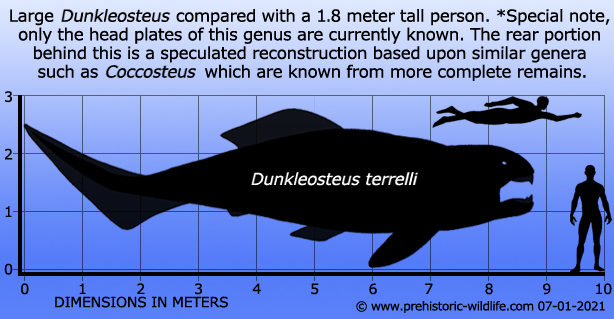
Dunkleosteus
proves two things; the placoderm fish that lived in the Devonian
could grow big, and be very dangerous. Only the bony head plates of
Dunkleosteus have been found, but discoveries of
other arthrodire
placoderms like the aforementioned Coccosteus has
allowed for what are
believed to be fairly accurate reconstructions of the whole fish.
Like
with other arthrodire placoderms, Dunkleosteus
did not have teeth,
instead two of the head plates of the upper and lower jaws were
modified into two broad shearing blades. These were driven by
exceptionally powerful jaw closing muscles that allowed these
‘blades’ to be driven through anything from prehistoric
sharks to
the bony plates of other arthrodire placoderms. In fact some fossils
of Dunkleosteus show what seems to have been damage
inflicted upon the
bony head plates by the jaws of another Dunkleosteus,
indicated
possible scavenging if not active cannibalism within these kinds of
fish.
1 - Coelacanths
The
final and number 1 entry is a bit strange because it is about a
kind of fish other than a specific genus. Coelacanths have been
around in the world’s oceans for hundreds of millions of years, and
for a long time when prehistoric animals first began to be studied,
coelacanths were believed to have died during the KT extinction 65
million years ago. This was plausible thinking for the time since no
coelacanth fossils were found in rocks that were formed after this time.
Then
in 1938 the scientific unthinkable happened; a living coelacanth
was pulled out of the Indian Ocean. This coelacanth had been caught
in the nets of a deep sea trawler, and although completely unknown by
the crew they had the quick thinking to keep it and send it to a museum
for study rather than toss it overboard. At the time scientists could
not believe there luck, indeed some called it a hoax or a
misidentification, but another coelacanth caught in 1952 quashed
these rumours.
Today
many coelacanths have now been caught, usually by fisherman casting
nets in deep ocean waters. These new coelacanths have been given the
genus name Latimeria and at the time of writing two
living species have
been identified, both in the Indian Ocean. Modern technology has
also allowed for coelacanths to be studied living underwater in their
natural environments. By day living coelacanths usually lurk amongst
caves keeping out of the way, but at night they emerge to slowly
cruise along the sea floor looking for things to eat.
Random favourites
 |
 |
 |
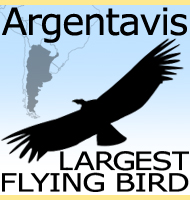 |

